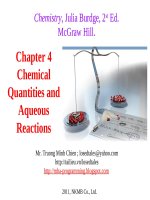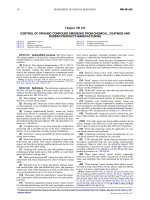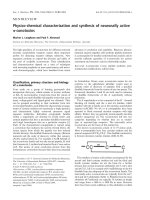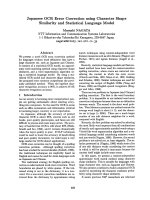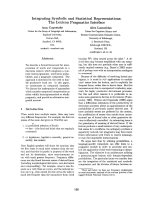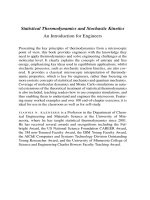Chemical thermodynamics and statistical mechanics
Bạn đang xem bản rút gọn của tài liệu. Xem và tải ngay bản đầy đủ của tài liệu tại đây (1.98 MB, 181 trang )
Chemistry 444
Chemical Thermodynamics and Statistical Mechanics
Fall 2006 – MWF 10:00-10:50 – 217 Noyes Lab
Instructor:
Prof. Nancy Makri
Teaching Assistant:
Adam Knapp
Office: A442 CLSL
E-mail:
Office Hours: Fridays 1:30-2:30
(or by appointment)
Office: A430 CLSL
E-mail:
Office Hours: Mondays 1:30-2:30
/>
Why Thermodynamics?
The macroscopic description of a system of ~1023 particles
may involve only a few variables!
“Simple systems”: Macroscopically homogeneous, isotropic,
uncharged, large enough that surface effects can be neglected, not
acted upon by electric, magnetic, or gravitational fields.
Only those few particular combinations of atomic coordinates
that are essentially time-independent are macroscopically
observable. Such quantities are the energy, momentum,
angular momentum, etc.
There are “thermodynamic” variables in addition to the
standard “mechanical” variables.
Thermodynamic Equilibrium
In all systems there is a tendency to evolve toward states whose
properties are determined by intrinsic factors and not by previously
applied external influences. Such simple states are, by definition,
time-independent. They are called equilibrium states.
Thermodynamics describes these simple static equilibrium states.
Postulate:
There exist particular states (called equilibrium states) of simple
systems that, macroscopically, are characterized completely by the
internal energy U, the volume V, and the mole numbers N1, …, Nr
of the chemical components.
The central problem of thermodynamics
is the determination of the equilibrium
state that is eventually attained after the
removal of internal constraints in a
closed, composite system.
Laws of Thermodynamics
What is Statistical Mechanics?
Link macroscopic behavior to atomic/molecular properties
Calculate thermodynamic properties from “first principles”
(Uses results for energy levels etc. obtained from quantum
mechanical calculations.)
The Course
Discovery of fundamental physical laws and concepts
An exercise in logic (description of intricate phenomena
from first principles)
An explanation of macroscopic concepts from our
everyday experience as they arise from the simple
quantum mechanics of atoms and molecules.
…not collection of facts and equations!!!
The Course
Prerequisites
•
•
Tools from elementary calculus
Basic quantum mechanical results
Resources
•
•
•
•
“Physical Chemistry: A Molecular Approach”, by D. A.
McQuarrie and J. D. Simon, University Science Books 1997
Lectures
(principles, procedures, interpretation, tricks, insight)
Homework problems and solutions
Course web site (links to notes, course planner)
Course Planner
o
o
o
o
o
Organized in units.
Material covered in lectures. What to focus on or review.
What to study from the book.
Homework assignments.
Questions for further thinking.
/>
Grading Policy
Homework
30% (Generally, weekly assignment)
Hour Exam #1 15%
(September 29th)
Hour Exam #2 15%
(November 3rd)
Final Exam
(December 14th)
40%
Please turn in homework on time! May discuss, but do not copy
solutions from any source!
10% penalty for late homework.
No credit after solutions have been posted, except in serious
situations.
Math Review
•
•
•
•
Partial derivatives
Ordinary integrals
Taylor series
Differential forms
Differential of a Function of One Variable
f
δf ≈
δf
δx
x
df
δx
dx
Differential of a Function of Two Variables
∂f
f ( x0 + δ x, y0 ) ≈ f ( x0 , y0 ) + ÷ δ x
∂x y
∂f
f ( x0 + δ x, y0 + δ y ) ≈ f ( x0 + δ x, y0 ) + ÷ δ y
∂y x
f
∂f
∂f
≈ f ( x0 , y0 ) + ÷ δ x + ÷ δ y
∂x y
∂y x
f (x0, y0)
y
(x0, y0+δy)
(x0, y0)
(x0+δx, y0+δy)
(x0+δx, y0)
x
df = f ( x0 + δ x, y0 + δ y ) − f ( x0 , y0 )
∂f
∂f
≈ ÷ δx+ ÷ δ y
∂x y
∂y x
Special Math Tool
If z = z ( x, y ), then
∂x ∂y ∂z
∂y ÷ ∂z ÷ ∂x ÷ = −1
z x y
PROPERTIES OF GASES
The Ideal Gas Law
PV = nRT or PV = RT , V = V /n
Extensive vs. intensive properties
Units of pressure
Units of temperature
1 Pa = 1 N m −2
1 atm = 1.01325 × 105 Pa
1 bar = 105 Pa
1
1 torr =
atm
760
Triple point of water occurs
at 273.16 K (0.01oC)
Deviations from Ideal Gas Behavior
PV
z=
RT
T=300K
“compressibility factor”
Ideal gas: z = 1
z < 1:
attractive intermolecular forces dominate
z > 1:
repulsive intermolecular forces dominate
Van der Waals equation
a
P + 2 ÷( V − b ) = RT
V
At fixed P and T, V is the solution of a
cubic equation. There may be one or three
real-valued solutions.
The set of parameters Pc, Vc, Tc for which the number of solutions changes
from one to three, is called the critical point. The van der Waals equation has
an inflection point at Tc.
Isotherms
(P vs. V at constant T)
∂P
T > Tc :
÷ <0
∂
V
T
∂P
÷ > 0 : unstable region
∂V T
Large V: ideal gas behavior.
Only one phase above Tc.
Unstable region: liquid+gas coexistence.
Critical Point of van der Waals Equation
RT
2a
∂P
=
−
+
÷
(V − b) 2 V 3
∂V T
2a (V − b) 2
= 0 for V =
RT
3
(3 or 1 real roots)
∂2P
2 RT
6a
=
−
2 ÷
3
4
∂V T (V − b) V
3a (V − b)3
= 0 for V =
RT
4
Both are satisfied at the critical (inflection) point, so...
Vc = 3b
8a
27 Rb
a
Pc =
27b 2
Tc =
The law of corresponding states
Eliminate a and b from the van der Waals equation:
2
b = 13 Vc , a = 27b 2 Pc = 3PV
c c , L ⇒
3
1 8
P
+
V
−
R
÷ = TR
2 ÷ R
V
3
3
R
PR ≡
P
V
T
, VR ≡ , TR ≡
"reduced" variables
Pc
Vc
Tc
All gases behave the same way under similar
conditions relative to their critical point.
(This is approximately true.)
Virial Coefficients
Z≡
PV
B
B
= 1 + 2V + 3V2 +L Virial expansion
RT
V
V
B2V : second virial coefficient,
B3V : third virial coefficient,etc.
Using partition functions, one can show that
B2V (T ) = −2π N A ∫
∞
0
(e
− u ( r ) / k BT
)
− 1 r 2 dr
u (r ): rotationally averaged intermolecular potential
Simple Models for Intermolecular Interactions
(a) Hard Sphere Model
u (r ) =
∞, r < σ
0, r > σ
2
L ⇒ B2V (T ) = π N Aσ 3
3
(b) Square Well Potential
∞, r < σ
u (r ) = −ε , σ < r < λσ
0, r > λσ
L ⇒
2
B2V (T ) = π N Aσ 3 1 − (λ 3 − 1) eε / kBT − 1
3
(
)
(c) Hard Sphere Potential with r-6 Attraction
∞,
r <σ
u (r ) = c6
− 6 , r >σ
r
L ⇒ B2V (T ) ;
2
c6
π N A σ 3 −
(high T )
3 ÷
3
k BT σ
Interpretation of van der Waals Parameters
From the van der Waals equation, …
B2V (T ) ; b −
a
RT
Comparing to the result of the square well model,
2
b = π N Aσ 3 ,
3
2
a = π N A2σ 3 ( λ 3 − 1) ε
3
Comparing to the result of the hard sphere model with r-6 attraction,
2
b = π N Aσ 3 ,
3
2
c
a = π N A2 63
3
σ
σ ; molecular diameter
b ; molecular volume (repulsive interaction)
a
related to strength/range of attractive interaction
The Lennard-Jones Model
c6
c
u (r ) = 4ε 12
−
÷
12
r6
r
Attractive term: dipole-dipole, or dipole-induced dipole, or induced
dipole-induced dipole (London dispersion) interactions.
